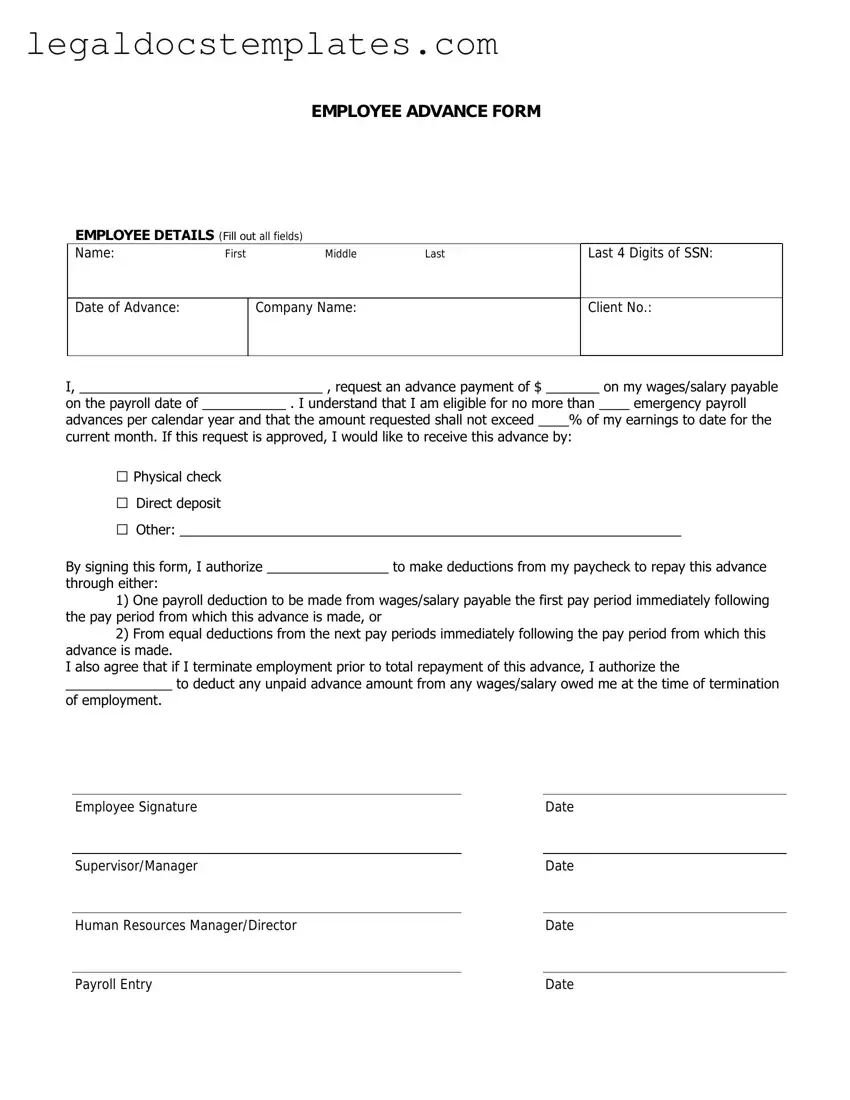The Employee Advance form is closely related to a Loan Agreement, where both documents formalize an arrangement involving a financial transaction between two parties. In the case of a Loan Agreement, it typically involves a lender and a borrower, whereas an Employee Advance form is specific to an employer and an employee. Both documents outline the amount of money being provided, the repayment schedule, and any interest or fees if applicable. They serve to protect the financial interests of both parties and ensure clear communication regarding the financial transaction.
Similarly, a Promissory Note shares common characteristics with an Employee Advance form. A Promissory Note is a binding agreement where one party promises to pay another a definite sum of money either on demand or at a specified future date. Like an Employee Advance form, it details the amount of money involved and the repayment terms. Both documents are legally binding and provide a clear record of the debt, which can be critical for financial accountability and legal recourse if disputes arise.
An Employment Contract also bears similarities to an Employee Advance form but with a broader scope. While an Employment Contract covers the overall terms and conditions of employment, an Employee Advance form is a specific element that might be included within such contracts. They both formalize the agreement between an employer and an employee and may address financial matters such as salary, benefits, and advances or loans.
The Payroll Deduction Authorization is another document similar to an Employee Advance form. This document authorizes an employer to deduct a certain amount from an employee's paycheck, often for purposes such as repaying an advance. Both documents involve agreements related to the employee’s salary and ensure that the terms of the financial transaction are clearly defined and agreed upon by both parties.
A Reimbursement Agreement is akin to an Employee Advance form in that it deals with the repayment or compensation for expenses, yet it typically focuses on expenses already incurred by the employee. Both agreements provide a framework for financial transactions between an employer and an employee, specifying terms and conditions under which money will be paid out and repaid.
Expense Reports can be considered similar to Employee Advance forms, as both deal with the management of finances between employers and employees. While an Expense Report is used to document and seek approval for expenses that have been incurred in the performance of work duties, an Employee Advance form relates to funds provided upfront. Both are tools used by businesses to manage financial transactions and ensure accountability.
A Credit Agreement shares similarities with an Employee Advance form in its financial transaction nature. Credit Agreements are used to detail the terms under which credit is extended from a lender to a borrower, including repayment terms, interest rates, and penalties for late payments. An Employee Advance form, while more specific to employment, similarly outlines terms under which money is loaned and expected to be repaid.
Compensation Agreements, which detail how an employee will be compensated for their work, including wages, bonuses, and other forms of payment, also share common ground with Employee Advance forms. While they cover a broader range of financial compensation, both types of documents may include provisions related to advances on wages or salary, making them interconnected in the broader spectrum of employment-related financial agreements.
Last but not least, a Debt Settlement Agreement, which is used when renegotiating or settling a debt under new terms, has parallels with an Employee Advance form. It involves an agreement on the repayment of a debt, potentially under new conditions. While typically used in more dire financial situations, both documents center around the negotiation and formalization of repayment terms for money owed, highlighting the emphasis on clear financial agreements between parties.

